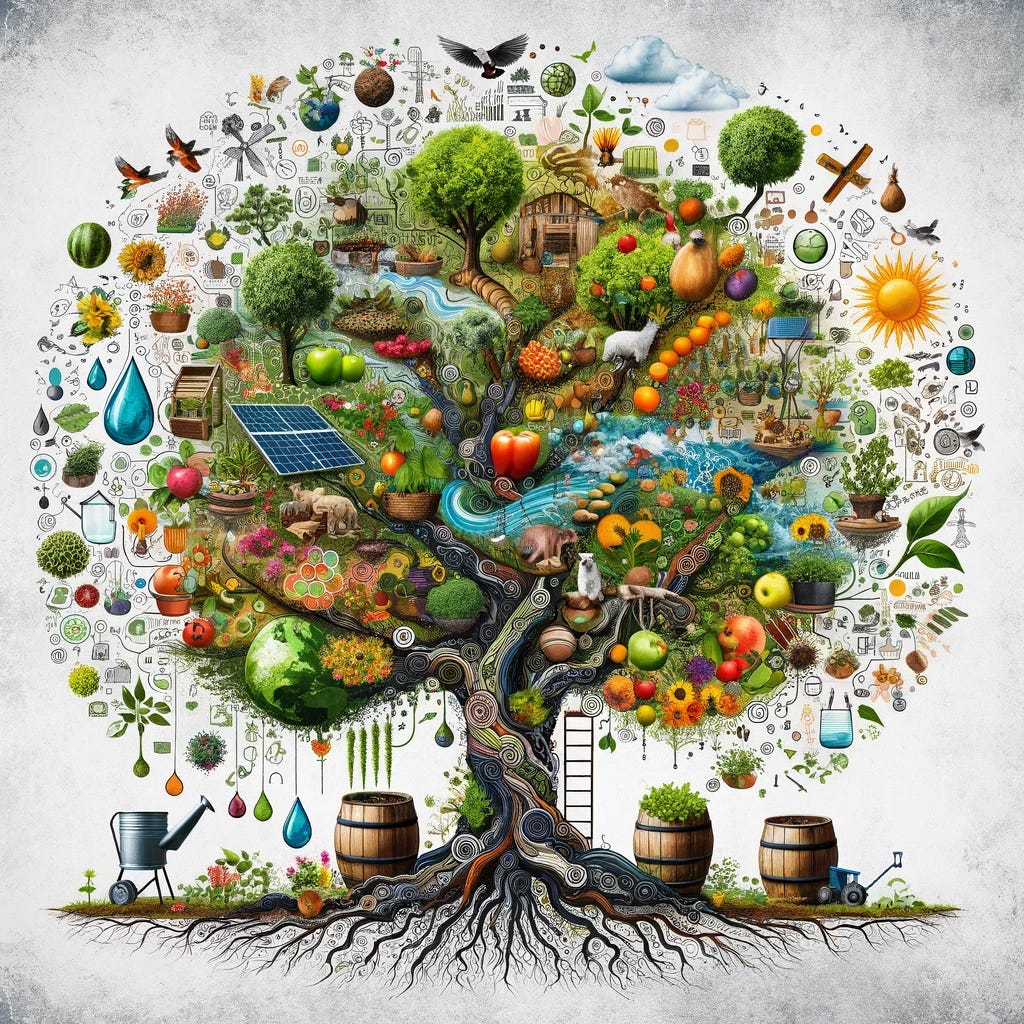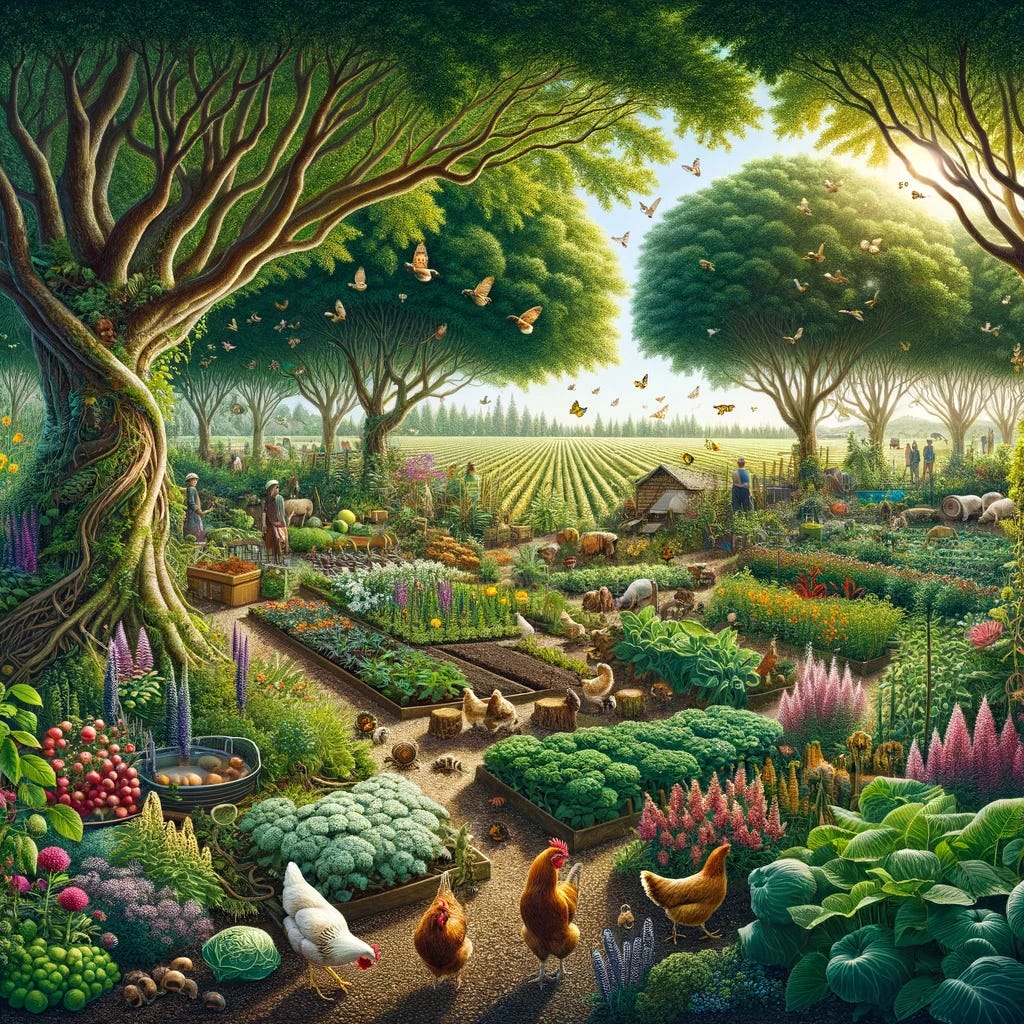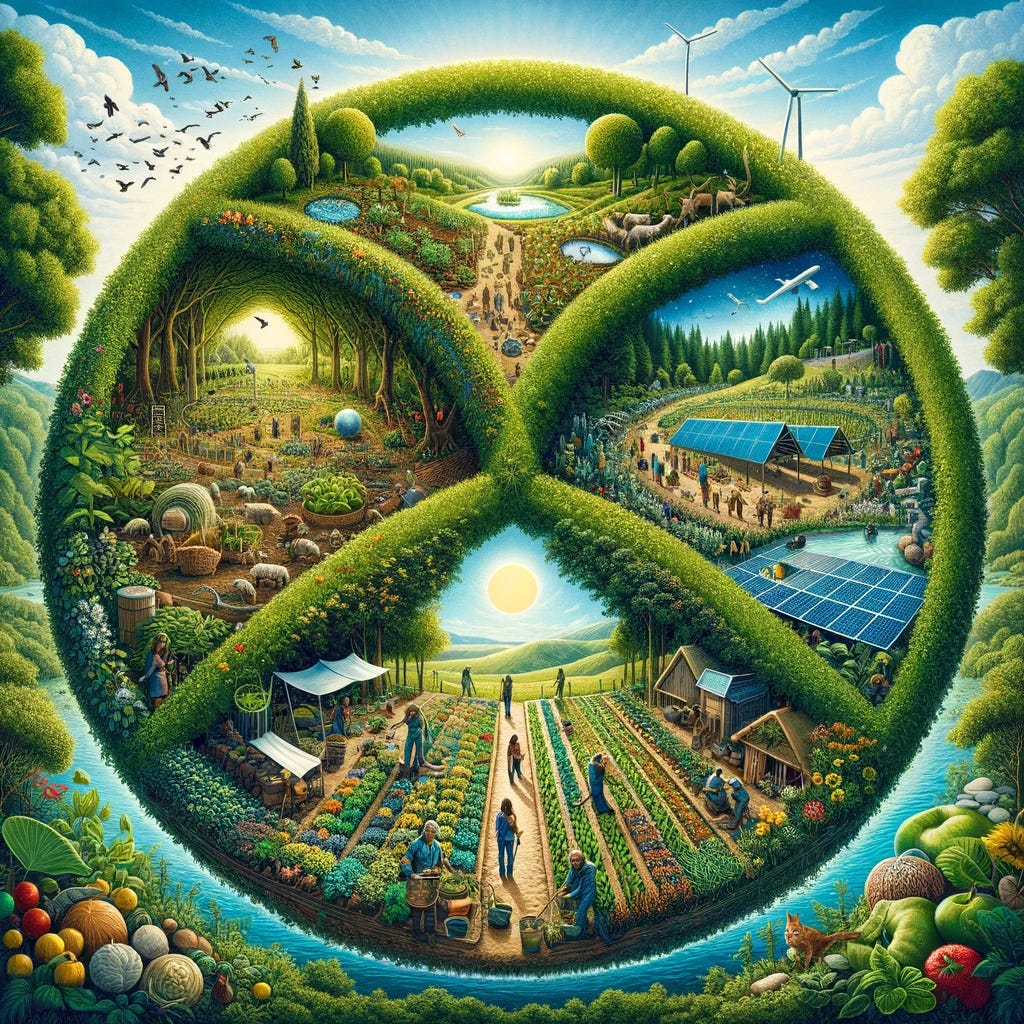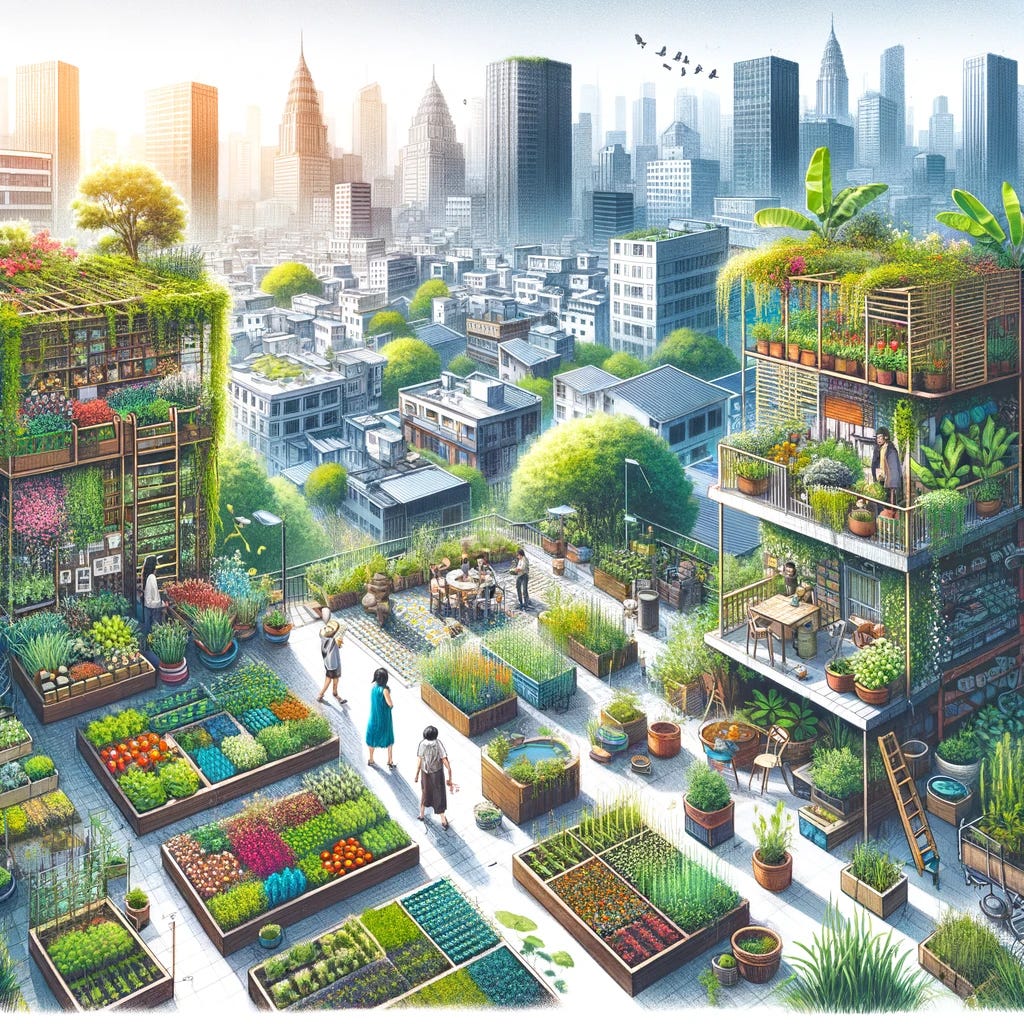Green Revolution: Unveiling the Secrets of Permaculture in Your Everyday Garden
From Soil to Sustainability: Your Essential Guide to Embracing Permaculture Principles
Permaculture, with its focus on sustainable and self-sufficient agricultural ecosystems, naturally raises many questions, especially for those new to the concept.
How Does Permaculture Differ from Traditional Gardening or Farming?
How Can Permaculture Help in Soil Conservation and Improvement?
What is Permaculture?
Permaculture is a holistic approach to designing sustainable and self-sufficient agricultural systems. It stands for "permanent agriculture" and extends beyond just farming practices to include a sustainable lifestyle. Developed in the 1970s by Australians Bill Mollison and David Holmgren, permaculture integrates land, resources, people, and the environment through mutually beneficial synergies, imitating the no-waste, closed-loop systems seen in diverse natural ecosystems.
The core of permaculture lies in its three ethics: Earth Care (preserving and regenerating natural resources), People Care (supporting and helping each other), and Fair Share (limiting consumption and sharing surplus). It emphasizes working with nature rather than against it, observing and learning from natural ecosystems, and recognizing the value of all living and non-living elements.
Permaculture principles include:
Observation and Interaction: Understanding the environment and its natural processes.
Energy and Resource Conservation: Efficiently using resources to minimize waste and energy consumption.
Cyclic and Regenerative Processes: Creating systems where outputs are reused to become inputs, thus minimizing waste.
Diversity and Resilience: Encouraging biodiversity to create resilient and productive systems.
Local Focus and Community Building: Emphasizing local resources and community collaboration to create sustainable and self-reliant systems.
In practice, permaculture can involve a range of strategies like companion planting, rainwater harvesting, composting, and integrating animals into the ecosystem. It can be applied in rural and urban settings, small gardens, and large farms, aiming to create sustainable and self-maintaining systems for food production and living.
How Does Permaculture Differ from Traditional Gardening or Farming?
Permaculture represents a significant shift from traditional gardening and farming, emphasizing a holistic and sustainable approach to agriculture. Its design philosophy is rooted in creating interconnected ecosystems that mimic natural processes, in contrast to traditional methods that often focus on immediate yields or aesthetic appeal. Permaculture seeks to establish self-sustaining systems that support a diverse range of flora and fauna, fostering a balanced and productive environment.
Sustainability is a key differentiator in permaculture. It minimizes reliance on external, non-renewable resources such as synthetic fertilizers and pesticides, favoring natural alternatives like composting and biological pest control. This approach not only conserves resources but also promotes a healthier ecosystem. In terms of plant cultivation, permaculture diverges from the conventional monoculture practice, advocating for biodiversity. This diversity supports a healthier soil ecosystem and reduces vulnerability to pests and diseases.
Soil and water management are other areas where permaculture stands out. It employs techniques like no-till gardening, mulching, and green manures to enhance soil health, in contrast to traditional methods that can lead to soil degradation. Water conservation is also integral to permaculture, utilizing efficient systems like rainwater harvesting and drip irrigation to reduce water usage.
Permaculture also recognizes the value of integrating wildlife into the ecosystem for natural pest control and pollination, seeing wildlife as beneficial collaborators rather than threats. This is in stark contrast to some traditional practices where wildlife is often considered a nuisance.
Lastly, permaculture is distinguished by its long-term perspective and resilience. It aims to create systems that are not only productive in the short term but also sustainable and adaptable to environmental changes over time. This approach ensures that permaculture gardens and farms can continue to thrive without exhausting natural resources, in contrast to some traditional practices which may prioritize immediate results over long-term sustainability.
In summary, permaculture offers a more sustainable, environmentally conscious approach to agriculture, focusing on the health of the entire ecosystem, efficient resource use, and long-term viability.
What Are the Core Principles of Permaculture?
The primary core principles of permaculture, conceptualized by Bill Mollison and David Holmgren, focus on creating sustainable and harmonious ecosystems. These principles guide the design and practice of permaculture, emphasizing working with nature rather than against it. The main principles include:
Observe and Interact: By taking time to engage with nature and observe the processes within the ecosystem, we can design solutions that suit our particular situation.
Catch and Store Energy: Design systems to collect resources at peak abundance for use in times of need. This can be applied to capturing water, sunlight, or even wind energy.
Obtain a Yield: Ensure that you are getting truly useful rewards as part of the work you are doing. This could be food, fiber, or even joy and learning.
Apply Self-Regulation and Accept Feedback: We need to discourage inappropriate activity to ensure that systems continue to function well. This includes being mindful of our own actions and their environmental impacts.
Use and Value Renewable Resources and Services: Make the best use of nature's abundance to reduce our consumptive behavior and dependence on non-renewable resources.
Produce No Waste: By valuing and making use of all the resources that are available to us, nothing goes to waste.
Design from Patterns to Details: By stepping back, we can observe patterns in nature and society. These can form the backbone of our designs, with the details filled in as we go.
Integrate Rather Than Segregate: By putting the right things in the right place, relationships develop between those things and they work together to support each other.
Use Small and Slow Solutions: Small and slow systems are easier to maintain than big ones, making better use of local resources and producing more sustainable outcomes.
Use and Value Diversity: Diversity reduces vulnerability to a variety of threats and takes advantage of the unique nature of the environment in which it resides.
Use Edges and Value the Marginal: The interface between things is where the most interesting events take place. These are often the most valuable, diverse, and productive elements in the system.
Creatively Use and Respond to Change: We can have a positive impact on inevitable change by carefully observing, and then intervening at the right time.
These principles are not just guidelines for farming or gardening but are also applicable to our personal, economic, and social lives. They are foundational in creating systems that are ecologically sound and economically viable, providing for their own needs, not exploiting or polluting, and therefore sustainable in the long term.
Can Permaculture Be Practiced in Urban Areas?
Simply put, yes, permaculture can definitely be practiced in urban areas. Urban permaculture adapts the principles of sustainable and ecological design to the unique conditions of urban environments. It's about creating efficient, productive, and sustainable living spaces within cities and towns. Here are some ways permaculture is applied in urban settings:
Small-Scale Gardening: Utilizing small spaces like balconies, rooftops, and backyards for growing food. Techniques such as vertical gardening, container gardening, and square foot gardening are often used.
Community Gardens: Transforming shared or public spaces into community gardens where people can grow food collectively. These gardens can become hubs for community interaction and learning.
Green Roofs and Walls: Implementing green roofs and living walls to grow plants, which can help with insulation, air purification, and creating urban greenery.
Urban Food Forests: Creating multi-layered systems of trees, shrubs, and groundcover plants that mimic natural forests but produce food.
Rainwater Harvesting: Collecting and storing rainwater for use in urban gardens, reducing reliance on municipal water supplies.
Composting and Waste Reduction: Implementing composting systems to recycle organic waste into valuable soil amendments.
Sustainable Transportation and Living: Encouraging walking, cycling, and the use of public transport, along with energy-efficient building design and solar energy use.
Pollinator-Friendly Spaces: Creating gardens that attract and support urban wildlife, including bees, butterflies, and birds, which are vital for plant pollination.
Urban permaculture is not just about gardening; it's a holistic approach to urban living that integrates food production, water management, waste recycling, and energy conservation. It offers practical solutions for sustainable living in densely populated areas and fosters a sense of community and connection to nature within urban settings.
How Can Permaculture Help in Soil Conservation and Improvement?
Permaculture offers various strategies for soil conservation and improvement, focusing on building and maintaining healthy soil ecosystems. These strategies are crucial, as healthy soil is the foundation of any sustainable agricultural system. Here’s how permaculture helps in this regard:
Organic Matter Addition: Permaculture emphasizes adding organic matter to the soil through compost, mulches, and green manures. This organic matter improves soil structure, enhances nutrient content, and boosts its water-holding capacity.
No-Till or Minimal Tillage: Traditional tilling can disrupt soil structure and microbial life. Permaculture often advocates for no-till or minimal tillage methods, which preserve the soil structure, reduce erosion, and maintain the health of the soil microbiome.
Cover Cropping: Planting cover crops like clover or vetch helps in protecting the soil from erosion, adding organic matter (when they decompose), and fixing nitrogen in the soil, enhancing its fertility.
Diverse Plantings: Diverse plantings and crop rotations in permaculture systems prevent soil depletion, reduce pest and disease cycles, and promote a balanced nutrient cycle.
Perennial Plants: Incorporating perennials, which have deeper root systems than annuals, helps in stabilizing the soil and bringing up nutrients from deeper layers.
Contour Planting and Swales: Planting on contours and using swales (shallow trenches on contour lines) help in capturing and evenly distributing water, reducing runoff and preventing soil erosion.
Encouraging Soil Life: Permaculture practices encourage a rich soil ecosystem, including worms, beneficial insects, and microorganisms. Healthy soil life contributes to nutrient cycling and soil structure improvement.
Mulching: Applying mulch not only conserves soil moisture but also prevents erosion, suppresses weeds, and gradually adds nutrients back to the soil as it decomposes.
Use of Polycultures and Guilds: Growing a variety of plants together (polycultures) and in mutually beneficial groups (guilds) promotes a healthy soil ecosystem, as different plants contribute different benefits to the soil.
Integration of Animals: Integrating animals like chickens, goats, or cows in a controlled manner can help in natural soil aeration and fertilization through their manure.
Permaculture's approach to soil conservation and improvement is about creating and maintaining a living, breathing soil system that’s capable of supporting healthy plant growth naturally, reducing the need for external inputs, and ensuring the sustainability of the ecosystem.
What Role Do Perennials Play in Permaculture?
Perennials play a pivotal role in permaculture systems, offering multiple benefits that align with the principles of sustainable and ecological gardening. Their inclusion in permaculture designs is based on several key advantages:
Soil Health and Stability: Perennials have deeper root systems than annuals. These roots help to stabilize the soil, reduce erosion, and improve soil structure. Their roots can also reach deeper into the soil to access nutrients and water, bringing them closer to the surface where they can be utilized by other plants.
Reduced Soil Disturbance: Unlike annuals, which need to be replanted each year, perennials remain in place for several years. This means less soil disturbance from planting and harvesting, which helps to maintain soil structure and the health of the soil microbiome.
Lower Maintenance and Resource Input: Once established, perennials often require less maintenance than annuals. They typically need less watering, fertilizing, and pest control, as they are generally more resistant to diseases and pests due to their established root systems and natural adaptations.
Year-Round Cover: Perennials provide year-round ground cover, which can help in weed suppression and moisture retention in the soil. This cover also offers habitat and food for beneficial insects and other wildlife.
Diversity and Resilience: Perennials contribute to the biodiversity of a garden, which is a key principle of permaculture. A diverse planting scheme with various perennials can create a more resilient system that is better equipped to handle pests, diseases, and changing climate conditions.
Continuous Harvest: Many perennials provide a continuous harvest over the season or become available at different times, ensuring a consistent supply of food.
Supporting Ecosystem Services: Perennials, especially native ones, play a crucial role in supporting local ecosystems. They provide essential services like pollination, habitat for wildlife, and nutrient cycling.
Microclimate Regulation: Through their permanent structure, perennials can help to modify the microclimate. They can provide shade, act as windbreaks, and influence moisture levels in their immediate environment.
In permaculture design, perennials are often used in combination with annuals and other elements like shrubs and trees to create a layered, integrated system. This approach maximizes the productivity and health of the garden or agricultural system, making it more sustainable and self-sufficient.
How Does Permaculture Address Water Management?
Permaculture addresses water management in innovative and sustainable ways, emphasizing conservation, efficient use, and maximizing the natural benefits of water in the ecosystem. The key strategies in permaculture for effective water management include:
Rainwater Harvesting: Capturing and storing rainwater is a fundamental aspect of water management in permaculture. This can involve using rain barrels, cisterns, or ponds to collect water from rooftops or other surfaces, which can then be used for irrigation or other purposes.
Swales and Contour Lines: Swales, which are shallow trenches built along the contour of the land, help to slow down and capture runoff water. This not only prevents erosion but also ensures that water seeps into the ground, recharging groundwater and providing moisture to plants.
Mulching: Applying mulch around plants helps to retain soil moisture by reducing evaporation. This also adds organic matter to the soil, improving its structure and water-holding capacity.
Drip Irrigation: Using drip irrigation systems delivers water directly to the plant roots, minimizing water loss through evaporation and ensuring efficient use of water.
Greywater Systems: Greywater, which is wastewater from sources like sinks and showers, can be treated and reused for irrigation in the garden, reducing the need for fresh water.
Keyline Design: This agricultural technique involves plowing and planting along the natural topography of the land, which helps to evenly distribute water throughout the landscape.
Plant Selection and Zoning: Choosing plants that are native or well-adapted to the local climate reduces the need for additional watering. In permaculture, the concept of zoning is used to place plants with similar water needs together to optimize irrigation efficiency.
Ponds and Water Features: Creating ponds or water features in a garden can help to regulate the microclimate, increase biodiversity, and provide a source of water for irrigation and wildlife.
Permaculture approaches water as a precious resource and integrates various techniques to manage and conserve it effectively. By mimicking natural water cycles and processes, permaculture systems ensure that water is used responsibly and sustainably, benefiting both the environment and the agricultural system.
Can Permaculture Be a Solution to Food Security?
Permaculture has the potential to be a significant part of the solution to food security issues, particularly as it offers a sustainable approach to agriculture and food production. Its principles and practices can contribute to food security in several key ways:
Sustainable Food Production: Permaculture systems focus on sustainable, long-term food production, using techniques that replenish and maintain soil fertility, conserve water, and reduce the need for chemical inputs. This approach can provide consistent and reliable yields over time.
Diversity of Crops: Permaculture emphasizes the cultivation of a wide variety of crops, which can lead to a more resilient food system. Diverse crops reduce the risk of total crop failure due to pests, diseases, or climate fluctuations, and they provide a range of nutrients for a balanced diet.
Local Food Systems: By encouraging local food production, permaculture reduces dependence on long supply chains that can be disrupted by economic or environmental factors. Localized food systems also cut down on transportation costs and associated emissions, contributing to both food security and environmental sustainability.
Community Empowerment: Permaculture often involves community-oriented approaches, such as community gardens and cooperatives, which can empower local communities to take control of their food sources, share knowledge, and support each other.
Adaptability to Various Environments: Permaculture designs are adaptable to a wide range of environments, from urban settings to rural farms, making it possible to grow food in areas that might not be suitable for conventional agriculture.
Education and Skill Building: Permaculture education focuses on teaching sustainable farming practices, soil management, water conservation, and other skills that are crucial for food security.
Resilience to Climate Change: Permaculture systems, with their emphasis on biodiversity and resource conservation, are generally more resilient to the impacts of climate change, such as extreme weather events and shifting climatic patterns.
While permaculture alone may not solve all aspects of global food insecurity, it provides a compelling framework for developing more sustainable, resilient, and equitable food systems. Its holistic approach to ecological and social elements of agriculture makes it a valuable model in addressing the complex challenge of feeding a growing global population in a changing world.
How Can I Start a Permaculture Garden in My Own Space?
Starting a permaculture garden in your own space is an exciting and rewarding endeavor. Here are some steps to guide you in creating a sustainable and productive permaculture garden:
Observe and Assess Your Space: Spend time observing your garden area. Note the sunlight patterns, wind direction, slopes, drainage, existing vegetation, and any other elements that affect your space. Understanding your local climate and ecosystem is crucial.
Plan Your Design: Based on your observations, start planning your garden layout. Consider the principles of permaculture, such as zoning (placing elements based on how frequently you need to access them), sector planning (managing wind, sun, and water flows), and vertical layering (using different plant heights to maximize space and resources).
Start Small: Begin with a manageable area to avoid feeling overwhelmed. You can always expand your garden as you gain experience and confidence.
Build Healthy Soil: Focus on building healthy, fertile soil. Start composting to create rich organic matter. Consider using techniques like sheet mulching to improve soil health without tilling.
Choose the Right Plants: Select a mix of perennial and annual plants that are suited to your climate and soil conditions. Incorporate a variety of edible, medicinal, and beneficial plants to create biodiversity.
Use Companion Planting: Implement companion planting to encourage beneficial interactions between different plants, such as pest control, nutrient uptake, and pollination.
Water Management: Implement efficient water management practices. Consider installing a rainwater harvesting system and using drip irrigation or soaker hoses to reduce water waste. Design your landscape to capture and utilize rainwater (e.g., through swales or rain gardens).
Integrate Animals: If possible, consider integrating animals like chickens or bees, which can provide benefits like pest control, fertilization, and pollination.
Create Compost and Recycling Systems: Set up compost bins to recycle organic waste into nutrients for your garden. This reduces waste and provides healthy compost to enrich your soil.
Build and Plant in Phases: Work in phases, gradually building and planting your garden. This allows you to learn and adjust your plans as you go.
Learn and Connect with Others: Read books, attend workshops, or join local gardening groups to gain more knowledge about permaculture principles and techniques. Connecting with other gardeners can provide valuable support and inspiration.
Observe, Tweak, and Maintain: Continuously observe how your garden is developing. Be prepared to tweak and adjust your plans as you learn what works best in your space.
Remember, permaculture is not just about planting; it's about creating a sustainable ecosystem. It's a gradual process that requires patience and observation. Enjoy the journey of learning and watching your garden flourish!
What Are the Challenges of Implementing Permaculture?
Implementing permaculture, while rewarding, can come with several challenges. Understanding and preparing for these challenges can help in successfully integrating permaculture principles into your gardening or farming practices:
Initial Learning Curve: Permaculture involves a diverse set of principles and techniques, which can be overwhelming for beginners. The initial learning curve can be steep as it requires understanding ecological principles, design techniques, and practical skills.
Time and Effort in Initial Setup: Establishing a permaculture system often requires significant time and effort, especially during the initial design and implementation phases. Building features like swales, ponds, or raised beds can be labor-intensive.
Adapting to Local Conditions: Permaculture emphasizes working with the local environment, which means that what works in one area might not work in another. This requires a deep understanding of local ecosystems, climate conditions, and soil types.
Managing Expectations: Permaculture systems can take several years to become fully productive. Managing expectations regarding timeframes for yields is important to prevent disappointment.
Financial Investment: While permaculture aims to reduce reliance on external inputs, initial setups like purchasing plants, materials for raised beds, or irrigation systems can require a financial investment.
Pest and Disease Management: While permaculture practices aim to create a balanced ecosystem that naturally controls pests and diseases, managing these can still be challenging, especially in the early stages before the system is fully established.
Legal and Regulatory Barriers: In some areas, there may be zoning laws, homeowners' association rules, or agricultural regulations that can restrict certain permaculture practices, such as keeping livestock, constructing rainwater harvesting systems, or altering the landscape.
Space Limitations: In urban environments, space limitations can make it challenging to implement certain permaculture practices. Creativity and adaptation are required to work within smaller or confined spaces.
Community Resistance or Lack of Support: Implementing permaculture can sometimes face resistance from neighbors or local communities who are unfamiliar with these practices. Gaining community support and involvement can be challenging.
Long-term Maintenance and Adaptation: Permaculture systems require ongoing observation and maintenance. The dynamic nature of ecosystems means that continuous learning and adaptation are necessary to address changing conditions over time.
Despite these challenges, permaculture offers a rewarding approach to sustainable living and farming. Many practitioners find that the benefits of healthier ecosystems, increased biodiversity, and sustainable yields far outweigh the initial challenges faced during implementation.
Each of these questions opens up a rich avenue for exploration and learning, reflecting the growing interest in sustainable living practices and the desire to harmonize agricultural practices with the natural environment.




